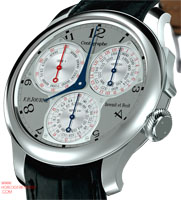

F.P Journe
Les nouveautés 2007 des montres F.P Journe
CENTIGRAPHE SOUVERAIN
Le mouvement manuel affiche les temps écoulés allant d’un centième de seconde à 10 minutes sur trois cadrans, chacun avec une échelle de temps affichée en rouge et une échelle tachymétrique en noir. Les échelles tachymétriques convertissent les unités de temps en vitesses allant de 6km/h — le pas de marche — à 360,000 km/h, bien au delà de la vitesse de libération d’une fusée atteignant la vélocité de satellisation minimale (première vitesse cosmique).
Les secondes foudroyantes à 10 heures font un tour de cadran en une seconde contre une échelle de centièmes de seconde. Il est donc théoriquement possible de chronométrer un objet allant à une vitesse de 360,000 km/h, ou approximativement 1/3000ème de la vitesse de la lumière. Sur le cadran à deux heures, l’aiguille fait son parcours en 20 secondes contre une échelle divisée en secondes.
L’échelle tachymétrique extérieure indique les vitesses du nombre impair des secondes — 1, 3, 5 etc. — tandis que l’échelle intérieure correspond aux secondes paires.
Le troisième cadran, à 6 heures, ou l’aiguille tourne en 10 minutes, à une échelle tachymétrique semblable, avec les vitesses correspondant aux divisions de 20 secondes. Ainsi un kilomètre parcouru en 3 minutes 40 secondes, par exemple, représente une vitesse de 16.4 km/h (à un décimal près).
Le chronographe est mis en marche, stoppé et remis à zéro par une bascule à 2 heures sur la carrure, au lieu des boutons classiques à chaque coté de la couronne. Cette solution ergonomique est brevetée. La bascule fait tourner une roue à colonnes qui agit sur des leviers pour la séquence marche, arrêt et zéro selon le système conventionnel.
Un deuxième brevet est accordé pour la configuration ingénieuse du mécanisme qui sert à isoler la fonction chronographe du mouvement.
Ainsi le chronographe n’a aucun effet sur l’amplitude du balancier. Ceci est grâce au ressort qui se désarme des deux côtés : l’arbre du barillet mène les rouages du chronographe, tandis que le rouage du mouvement est mené par le barillet lui-même. (système semblable au ressort de la Sonnerie Souveraine).
Le compteur d’une seconde et celui des 20 secondes sont menés par deux rouages partant en deux directions d’une roue intermédiaire tournée par l’arbre du barillet. Un rouage séparé, aussi mené par l’arbre du barillet, active l’aiguille chronographe de 10 minutes.
Les secondes foudroyantes à haute vitesse, réglées par l’échappement du mouvement, font un tour saccadé en 16 sauts par seconde. Une roue solidaire avec la roue des secondes (4ème roue) du rouage mouvement est engagée avec un pignon qui porte l’aiguille foudroyante.
Les secondes foudroyantes sont ainsi menées par le rouage mouvement partant du barillet et aussi par le rouage chronographe partant de l’arbre du barillet. Un aspect insolite des secondes foudroyantes est de pouvoir les stopper à n’importe quel moment de leur parcours, même entre deux divisions de centième de seconde, permettant ainsi une lecture fractionnelle approximative.
Ceci est rendu possible en débrayant verticalement le pignon foudroyant de l’échappement. Un mécanisme de levier ingénieux convertit un mouvement latéral en mouvement vertical, faisant tomber le pignon sur un frein.
L’aiguille des 20 secondes et celle des 10 minutes sont remises à zéro par des leviers marteaux agissant sur des colimaçons. Ceci élimine le jeu associé avec les pièces coeur classiques, tout en assurant un retour à zéro dans le sens inverse des aiguilles d’une montre. L’aiguille des secondes foudroyantes est arrêtée à zéro par un bec saillant de son pignon rencontrant un levier.
Le barillet est doté d’un système de remontoir auxiliaire (maintaining power) pour assurer que sa force motrice ne soit pas interrompue par le remontage. La réserve de marche du ressort moteur est au moins 90 heures, et 45 heures avec le chronographe en marche.
The hand-wound movement measures elapsed times from one hundredth of a second to 10 minutes on three dials, each with a time scale in red and a tachometer scale in black. The tachometer scales convert times into speeds ranging from 6 km/h — walking pace — to 360,000 km/h, well above the escape velocity of a rocket going into low-level orbit.
The flying-seconds hand at 10 o’clock goes around the dial in one second against a scale marked in hundredths of a second, making it theoretically possible to time an object moving at 360,000 km/h, or approximately 1/3000ths of the speed of light. On the dial at 2 o’clock, the hand goes around in 20 seconds and the time scale is marked in seconds. The outer tachometer scale shows the speed against odd numbers of seconds — 1, 3, 5, etc. — while the inner scale corresponds to the even numbers of seconds. The third dial, at 6 o’clock, where the hand goes around in 10 minutes, has a similar tachometer scale with speeds corresponding to 20-second markers. Thus a kilometre travelled in three minutes 40 seconds represents a speed of 16.4 km/h (to one decimal place).
The chronograph is started, stopped and zeroed by a rocker at 2 o’clock in the caseband instead of the usual buttons on either side of the crown — an ergonomic solution that has been granted a patent. The rocker turns a column-wheel that activates the levers in the start, stop and zero sequence in the conventional way.
A second patent has been granted for the ingenious configuration of the mechanism, which effectively isolates the chronograph from the timekeeping function. This means the amplitude of the balance is unaffected when the chronograph is running. This is achieved by using a single mainspring that unwinds at both ends, driving the chronograph trains from the barrel arbor, and the going train of the movement from the barrel itself. (This is similar to the mainspring system used in the Sonnerie Souveraine clockwatch). The one-second counter and the 20-seconds counter are driven by two wheel-trains departing in either direction from a single intermediate wheel working off the barrel arbor. A separate train of wheels, also driven by the barrel arbor, moves the 10-minutes chronograph hand.
The high-speed, flying seconds, released by the escapement of the watch, jumps around the dial 16 times a second. A wheel, mounted on the fourth wheel of the movement engages a pinion carrying the flying-seconds hand. This means that the flying seconds are driven by both the going train of the movement, working off the barrel, and the chronograph train, working off the barrel arbor. One ingenious feature of the flying-seconds hand is that it can be stopped anywhere along its one-second journey around its dial, even between two 100th-second divisions, enabling an approximate fractional reading. This is done by vertically disengaging the pinion of the flying seconds from the escapement. A device converting lateral movement into vertical movement pushes the pinion down onto a brake.
The 20-seconds hand and the 10-minutes hand are zeroed by hammer levers acting on snail cams. This eliminates the play inherent in the conventional heart-pieces while ensuring that the two hands return to zero anti-clockwise. The flying-seconds hand is stopped at zero by a beak protruding from its pinion coming against a lever.
Maintaining power ensures that the watch can be wound without interrupting the driving power to the movement or running chronograph. The mainspring delivers at least 90 hours of power reserve, and 45 hours with the chronograph running
UN NOUVEAU CALIBRE ET DEUX NOUVEAUX MODELES OCTA
Toujours à l’écoute des remarques et observations concernant ses produits, François Paul Journe témoigne :
« Je me suis rendu compte que l’Octa d’un de mes amis, n’était jamais remontée complètement car celui-ci travaille sur son ordinateur et sa main droite ne bougeait pas assez !” C’est de cette observation qu’il va créer le nouveau calibre Octa (1300-3) qui utilise le moindre mouvement au bénéfice du remontage automatique.
Avec talent, l’horloger inverse la problématique et créé un nouveau rotor qui se remonte dans une seule direction par un système de roulement à billes, contrairement au premier calibre Octa. Les billes en céramiques permettent à celui-ci de bouger dans une direction et le bloque dans l’autre.
Quand l’utilisateur est immobile, le rotor retrouve sa place initiale. Ainsi chaque infime mouvement est exploité au maximum pour un remontage optimisé de la montre.
Il possède néanmoins les caractéristiques classiques de l’Octa avec : cinq jours de réserve de marche (120h), un balancier à inertie variable pour un rendement optimum qui offre à tous les modèles de la ligne Octa une stabilité irréprochable.
Toujours suivant les observations de sa clientèle, François Paul Journe profite de la création de ce nouveau calibre pour proposer deux nouveaux modèles avec un affichage horaire central: « Certains de nos clients m’ont fait part de la difficulté de lire l’heure sur le cadran de l’Octa classique, ainsi j’ai profité de la création de ce nouveau calibre pour créer l’Octa automatique Réserve et l’Octa automatique Lune dont le cadran est inspiré du Chronomètre Souverain, qui a d’ailleurs remporté le Grand prix d’horlogerie de Genève en 2005 dans la catégorie Montre Homme ».
Always taking into account the notes and observations concerning his products, François Paul Journe states,
“I realized that one of my friend’s Octa was never completely wound because he works on a computer and his right hand doesn’t move enough.”
It is from this observation that he will create the new Octa caliber (1300-3) that uses the slightest movement to automatically wind the watch.
With talent, the watchmaker turns the problem around, and creates a new rotor that winds in only one direction with a ball bearing system, contrary to the first Octa caliber. The ceramic balls allow the rotor to move in one direction and block it in the other. When the user is immobile, the rotor goes back to its original position. In this way, every infinitesimal movement is maximally exploited for an optimized winding of the watch. The new caliber retains the characteristics of the classic Octa with: a five day power reserve (120H) and a variable inertia balance wheel for an optimum yield that offers each model of the Octa line an irreproachable stability.
Also in accordance to his clients’ observations, François Paul Journe takes advantage of this new caliber to offer two new models with central hands : « Some of our clients told me they had difficulty reading the time on the classical Octa dial, so I took advantage of the new caliber’s creation to build the Octa Automatic Reserve and the Octa Automatic Lune whose dial is inspired by that of the Chonomètre Souverain – watch that won the Geneva Watchmaking Grand Prix in 2005 in the Men’s Watch category ».



